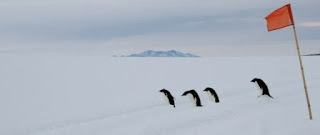The McMurdo shuttle (Ivan the Terra bus) was due to pick the 12 of us departing kiwis up from Scott Base at 1200, however it was a good 45 mins before it actually arrived. If I didn't think Antarctica could amaze me anymore, that 45 minute wait proved otherwise! As we (the ‘departees’ and fare welling party) stood gathered at the HFC (Hillary Field Centre) we were joined by another party of onlookers. Less than 100 metres offshore in sea ice holes just in front of the pressure ridges, a Minke whale (or two?) came to bid us farewell. Every so often they would rise to the surface spouting water high up into the air as they took a breath, and then intermittently they would lift their heads up out of the water. They were so graceful .. it was amazing to watch! So with the Minke's appearing inquisitively every 5-10 minutes, and with the seals lounging around the sea ice holes nearby, as well as having new friends from Scott Base nearby, it was a very special moment! - surely the best send-off party I could've imagined! (unfortunately I don't have photos of this incredible wildlife display .. but the picture at this link http://upload.wikimedia.org/wikipedia/en/4/46/Minke_whale_in_ross_sea.jpg provides a vague idea of what it was like!)
I was so sad leaving Scott Base and Antarctica yesterday .. I know that I am so incredibly lucky to have had this experience at all, and I have had such a fantastic time, but to get on that plane and have no idea whether I would ever be able to set foot in Antarctica again was difficult to say the least! This nine day experience will forever hold a special place in my heart and I am really looking forward to sharing my experience with as many people as possible.
Here are some pictures from my last day in Antarctica:
 The cute little 'beach front' church at McMurdo
The cute little 'beach front' church at McMurdo A snapshot of McMurdo Station. The brown buildings in the background are the accommodation blocks. Note the overhead power cables - definately not what I had expected to see in Antarctica.
A snapshot of McMurdo Station. The brown buildings in the background are the accommodation blocks. Note the overhead power cables - definately not what I had expected to see in Antarctica. The tanker in port ready for the annual re-stocking of the fuel supplies. The icebreaker can be seen in the channel in the background.
The tanker in port ready for the annual re-stocking of the fuel supplies. The icebreaker can be seen in the channel in the background. The Scott Base - McMurdo intersection
The Scott Base - McMurdo intersection My lunch bag for the trip home "Sir Peter's Ambassador" - thanks guys .. every single meal we had was delicious, and that lunch was no exception!
My lunch bag for the trip home "Sir Peter's Ambassador" - thanks guys .. every single meal we had was delicious, and that lunch was no exception! Some of the crew before departing: Stephen Sun, John McCrone, ??, Matt Vance, Jack Tame, Me and Dan O'Sullivan.
Some of the crew before departing: Stephen Sun, John McCrone, ??, Matt Vance, Jack Tame, Me and Dan O'Sullivan. My last view of Scott Base (bottom right), Crater Hill (top right), the wind turbines (top left) and the Newman Glacier (affectionately known as Frank) :) (bottom left)
My last view of Scott Base (bottom right), Crater Hill (top right), the wind turbines (top left) and the Newman Glacier (affectionately known as Frank) :) (bottom left)  The C17 landing at Pegasus
The C17 landing at Pegasus The last photo of me in Antarctica
The last photo of me in Antarctica Boarding the plane
Boarding the plane The cargo being loaded on board
The cargo being loaded on board My last view of an Antarctic glacier from the cockpit
My last view of an Antarctic glacier from the cockpit A spacious flight home -- one crew member even set up a bed to make the trip home as comfortable as possible!
A spacious flight home -- one crew member even set up a bed to make the trip home as comfortable as possible! Landing in Christchurch with a dull and very wet evening to welcome us!
Landing in Christchurch with a dull and very wet evening to welcome us!




















































